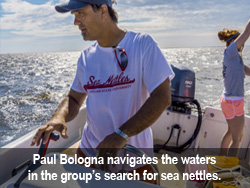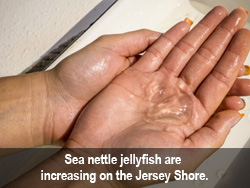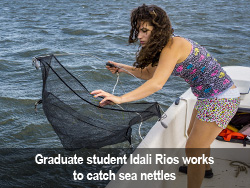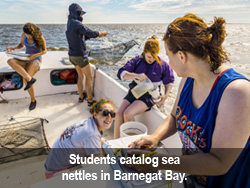Stemming the Tide

by Rebekah Herbison
In the early hours of a summer morning, sunlight glints across the surface of Barnegat Bay as Associate Professor Paul Bologna, director of Montclair State’s Marine Biology and Coastal Sciences program, and his team of graduate and undergraduate students load their equipment onto a small boat. Their interest is not in the picturesque setting, but in what lies beneath – a species of stinging jellyfish that is increasingly invading New Jersey’s coastal waterways.
Known as sea nettles (Chrysaora quinquecirrha), these troublesome jellyfish are pale white and bell-shaped, with long thin tentacles and reddish markings along the edges. The fact that these jellyfish are in Barnegat Bay is no surprise – they have long made it their home; however, the rapid increase in numbers and new locations concerns researchers and environmentalists alike.
 Economic impact
Economic impact
“The rise in sea nettles is having an environmental and economic impact, to the point where some areas have become un-swimmable at certain times,” Bologna explains. “It can potentially lead to decreased property values and a whole host of other issues. They’re basically the ‘great white shark’ of the bay – top predators that almost nothing else eats, except in the larvae and juvenile stages.”
Several potential causes exist for the jellyfish population explosion, including development around the bay that may provide more places for the polyps, the small life stage that produces baby jellyfish. A single floating dock can hold thousands of sea nettle polyps that can produce millions of adult jellyfish. Another contributing factor is lower salinity levels – also a result of waterfront development – and changes in water temperatures from climate change.
“One of the things that sea nettles like is low salinity, and the salinity in the northern part of the bay tends to be lower, so we think that’s where the sea nettles are the most highly concentrated. But they’re popping up all over now and once they’ve established themselves they aren’t going anywhere,” Bologna says.
A global concern
In June, Bologna and fellow researcher Associate Professor John Gaynor of the Department of Biology and Molecular Biology traveled to Hiroshima, Japan, to present their findings at the Fourth International Jellyfish Bloom Symposium. There, much of the talk centered on the growing problem of a species called Nomura’s jellyfish. Weighing up to 400 pounds, these gigantic jellyfish are literally clogging the Sea of Japan and wreaking havoc on the country’s fishing industry.
“Tensions are rising between China and Japan because the belief is that pollution, which is coming into Japan from the East China Sea, is causing the problem,” Bologna explains. “While there’s no fear of any of the jellyfish that we have here developing into one of these huge monsters, there is concern because all it would take is one ship coming from the western Pacific with larvae that settle in our waters, and all of a sudden we’ll have them here.”  While remote, the possibility of Nomura’s jellyfish migrating to U.S. waters when so little is known about the jellyfish already here makes the Montclair State research even more essential. The team’s findings have shown that sea nettle larvae in Barnegat Bay are being pulled into the Atlantic Ocean, opening up the potential for larvae and juveniles to travel along the coastline and invade additional estuaries.
While remote, the possibility of Nomura’s jellyfish migrating to U.S. waters when so little is known about the jellyfish already here makes the Montclair State research even more essential. The team’s findings have shown that sea nettle larvae in Barnegat Bay are being pulled into the Atlantic Ocean, opening up the potential for larvae and juveniles to travel along the coastline and invade additional estuaries.
“They’re already established in the Navesink River, so we’re literally one step away from these guys jumping up into Long Island and even further up the coastline,” Bologna says. “Sea nettles have never been seen in these locations and in these kinds of numbers. With lower water quality and rising ocean temperatures, these guys are slowly inching their way north.”
The New Jersey Department of Environmental Protection is funding the University’s three-year project, now in its second year. In the first year, Bologna and Gaynor focused solely on specific sites within the bay itself. This year, eight lagoons were added and, through the cooperation of more than 40 volunteers who live along the bay, they are looking for “hotspots” of settling polyps. In addition to the lagoons, the team surveys 16 bay sites, covering approximately 34 miles.
“It’s been great to have partners to assist us,” Bologna says. “Their involvement has really helped us increase the number of places we’re able to study. The general public is fairly well informed and concerned about the state of the bay and wants to preserve it.”
Bologna’s students are also integral to the project and are enthusiastic about the type of hands-on experience it provides.
“Doing hands-on research is a dream come true,” says Idali Rios, a graduate student in the Marine Biology and Coastal Sciences program. “This is just another piece of the puzzle in trying to understand these unique creatures.”
Christie Lynn Castellano, also a graduate student in the Marine Biology and Coastal Sciences program, echoes Rios’ sentiment, saying, “Our research regarding jellyfish populations in Barnegat Bay is the backbone of my graduate thesis. Being heavily involved in the field and the lab has allowed me to really understand the organisms that make their home in the bay, as well as the intricacies of how the bay system affects their success and survival.”
 A delicate balance
A delicate balance
While sea nettles are a nuisance to beachgoers, they are beneficial to the ecosystem, Bologna says. “They’re important for food webs and sequestering carbons. When they die they sink to the bottom of the ocean and take a lot of energy from the water column down with them,” he says. “So, if you create a lot of primary production on the surface of the ocean, as it dies and sinks, it draws carbon out of the atmosphere, helping to reduce global warming. They are critically important, just misunderstood.”
Next steps
It’s little wonder then that one of Bologna’s main goals is to shed more light on these creatures and learn more about their stages of development, food sources and reproductive cycle.
“If you’re going to understand a problem, you need to adequately understand the information,” Bologna explains. “We’re not looking to eradicate sea nettles. They’re too important and it would be an impossible venture. Our goal is to find a way to minimize the problem, but there are a lot of things we need to know first. Every day, we’re learning just a little bit more.”
